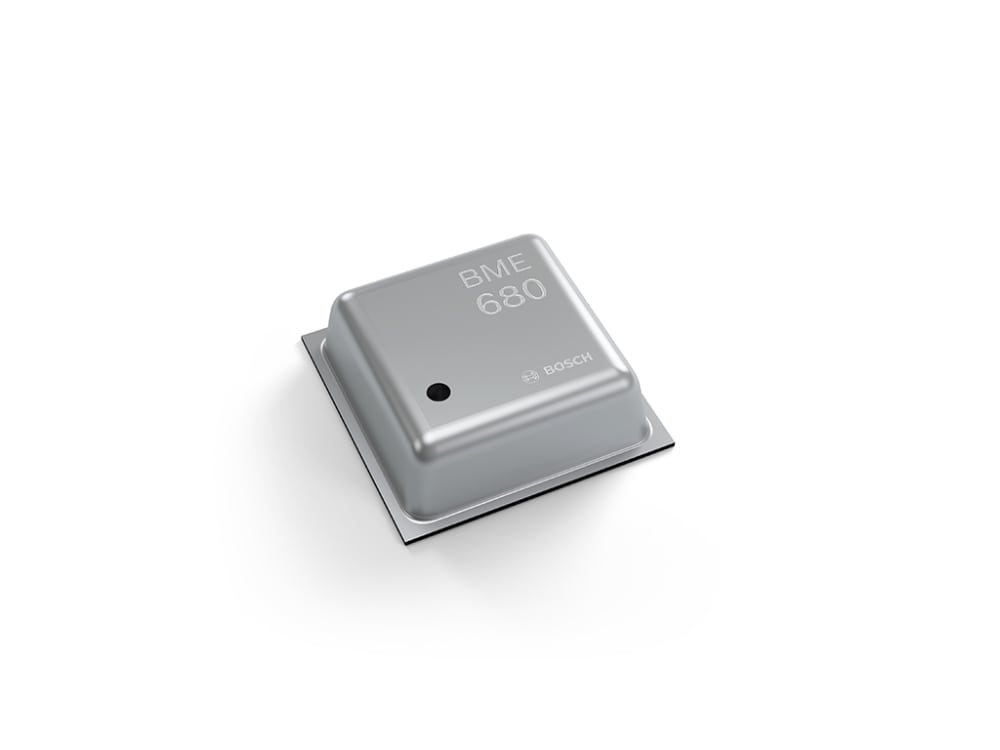

BME680 is a four-in-one sensor due to integration of four different parameters - ambient temperature, relative humidity, barometric pressure and gas - in one tiny package of 3.0 x 3.0 x 0.95 mm³. The gas sensor measures VOCs (Volatile Organic Compounds) which are significantly responsible for the deterioration of air quality and are more harmful for the human body than CO2. The BME680 enables for the first time to determine indoor air quality in a very accurate and cost-efficient manner, helping to improve people's health, well-being and quality of life.
The measurement principle for the gas sensor is based on a metal oxide like SnO2 which is heated up to a temperature of more than 300°C. O2 molecules are adsorbed on the surface of the metal oxide agglomerates and are trapping electrons as ionosorbed oxygen species (e.g. O-). Reducing gases, such as CO, react with the oxygen species to form gaseous CO2 and as a result increase the electrical conductivity. The pressure sensor is using a unique piezoelectric MEMS (micro-electro-mechanical-systems) technology to measure changes in pressure by converting them to an electrical charge temperature measurement is realized with a diode. The humidity sensor is a polymer which changes its resistance based on the humidity level.
The BME680 is the first four-in-one sensor in the market to address completely new markets like smart home and IoT for environmental sensing. The lowest power consumption in the market (below 0.1 mA) makes BME680 suitable for battery driven devices like smoke detectors to run up to two years without battery change. Simultaneously, BME680’s lifetime expectancy runs up to ten years. It is a significant milestone to provide four-sensors-in-one, minimizes size of environmental sensors (factor 5), reduces costs, improves accuracy (the integrated temperature and humidity sensors compensate the environmental effect) and most important, decreases power consumption (factor 100).
BME680 is based on a CMOS (ASIC) and MEMS (sensor) process which is the most efficient way for low-cost manufacturing.
BME680 is implement easily into customer products. The sensor unit comes calibrated and is operated by a sophisticated software algorithm which includes BSEC fusion library and is conceptualized to provide higher-level signal processing and fusion for the BME680. The library receives compensated sensor values from the sensor API. It processes the BME680-signals in combination with the additional phone sensors to provide the requested sensor outputs.
Key features are the precise calculation of: ambient air temperature, ambient relative humidity, barometric pressure and indoor air quality (IAQ) level (respectively outside the device).
The sensor has unlimited possibilities. Some of the applications include: health monitoring/ well-being (warning regarding dehydration/heat stroke), home automation control, control heating/venting/air conditioning (HVAC) applications, gaming, IoT, context awareness, enhancement of GPS navigation, indoor and outdoor navigation, leisure and sports, weather forecasts, health care applications and vertical velocity indication.
Due to its small size, BME680 addresses smartphone and wearable markets. Besides, defined markets are IoT, smart home, smart energy, smart transportation, HVAC, elderly care, sport/fitness and industry. Total addressable market has a volume of over 500 mio.
Video
-
Awards
-
 2017 Electronics/Sensors/IoT Honorable Mention
2017 Electronics/Sensors/IoT Honorable Mention -
 2017 Top 100 Entries
2017 Top 100 Entries
Like this entry?
-
About the Entrant
- Name:Thomas Block
- Type of entry:teamTeam members:Dr. Thomas Block - Product Manager BME680
- Software used for this entry:EnvironmentalLib Software (BSEC)
- Patent status:patented

